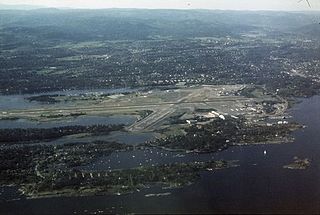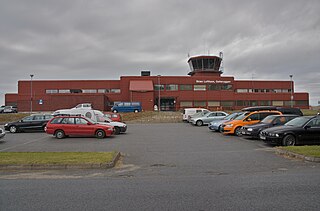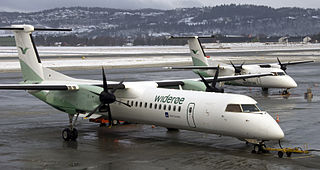
Sandefjord Airport, Torp is a minor international airport located 4 nautical miles northeast of Sandefjord and 110 kilometers (68 mi) south of Oslo in Norway. The airport features a 2,989-meter (9,806 ft) runway aligned 18/36. Torp partially serves as a regional airport for Vestfold and in part as a low-cost airport for Eastern Norway and the capital, Oslo. Widerøe have a base at Torp, serving both domestic and shorter International flights. It also sees scheduled flights by airBaltic, Ryanair, Wizz Air, Norwegian and KLM Cityhopper. As of 2021, it is the second-largest airport in eastern Norway in terms of flights after Rygge shut down in 2016.

Busy Bee was an airline which operated in Norway between 1966 and 1992. Entirely based around wet lease, it conducted a mix of regional services for larger airlines and the military, as well as corporate, ad hoc and inclusive tour charters.

Oslo Airport, Fornebu(IATA: FBU, ICAO: ENFB) was the primary international airport serving Oslo and Eastern Norway from 1 June 1939 to 7 October 1998. It was then replaced by Oslo Airport, Gardermoen, and the area has since been redeveloped. The airport was located at Fornebu in Bærum, 8 km (5.0 mi) from the city center. Fornebu had two runways, one 2,370 m (7,780 ft) 06/24 and one 1,800 m (5,900 ft) 01/19, and a capacity of 20 aircraft. In 1996, the airport had 170,823 aircraft movements and 10,072,054 passengers. The airport served as a hub for Scandinavian Airlines System (SAS), Braathens SAFE and Widerøe. In 1996, they and 21 other airlines served 28 international destinations. Due to limited terminal and runway capacity, intercontinental and charter airlines used Gardermoen. The Royal Norwegian Air Force retained offices at Fornebu.
Partnair A/S was a Norwegian charter airline which operated from 1971 to 1989. During the later 1980s it was Norway's fifth-largest airline by revenue, operating a fleet of three Convair CV-580 and six Beechcraft Super King Air. The airline was based at Oslo Airport, Fornebu, as well as operating a base at Stavanger Airport, Sola.

Skien Airport, Geiteryggen is a regional airport located at Geiteryggen, 5.5 kilometers (3.4 mi) southwest of the city center of Skien, Norway. Owned by Skien Municipality, it was last served by Widerøe with daily flights to Bergen. The runway is 1,416-by-30-meter and numbered 01–19. The airport had 33,080 passengers in 2014 and has Grenland and the southern part of Telemark as its catchment area.
Vildanden AS was a virtual, regional airline based at Skien Airport, Geiteryggen in Norway, where it was the only airline. With operations starting in 2005, it flew to Bergen, Trondheim and Stavanger using a Jetstream 32 and an ATR 42, which is wet leased from Danish Air Transport (DAT) and Helitrans. Previously, the airline has also served Stockholm and Molde, and has also operated Saab 340 aircraft, operated by Coast Air, Air Aurora and Avitrans. The airline had been in conflict with Coast Air about terminating the wet lease agreement. The company has had to be bailed out several times, including by the municipality, until it managed to make its first profit in 2009. It ceased operations and filed for bankruptcy in January 2011.
Norsk Air was a Norwegian airline based at Sandefjord Airport, Torp. At its height from the mid-1980s and onwards it operated scheduled flights to Stavanger, Bergen, Trondheim and Copenhagen, and for shorter periods also other Norwegian and international destinations. The airline had 156 employees and 150,000 annual passengers in 1989. The company was established as a sole proprietorship by Øyvind Skaunfelt as Vestfoldfly in 1961, after purchasing Thor Solberg's aviation school at Tønsberg Airport, Jarlsberg. In addition to an aviation college, the company operated various charter services using mostly Cessna aircraft. The company split into a flying school and an airline in 1972, with the latter taking the name Norsk Flytjeneste. Three 50-passenger Douglas DC-6 were subsequently bought and were among other places flown with aid charters to Bangladesh. Both the DC-6 and later charter flights with business jets proved unprofitable and were quickly terminated.

Notodden Airport is a municipal regional airport at Heddal in Notodden, a municipality in Vestfold og Telemark county, Norway. The airport is mostly used for general aviation, and has extensive sailplane activity. In 2011, the airport had 5,078 aircraft movements and 3,423 passengers. The airport has a single 1,393-by-40-meter runway with flight information service and instrument landing system. In connection with the airport is a water aerodrome, which uses the lake of Heddalsvatnet for take-off and landing.
Vest-Telemark Airport, Fyresdal is an airport in Fyresdal municipality in Vestfold og Telemark, Norway. It does not service commercial aircraft. Was until 2008 operated by Airparc Fyresdal and in a joint venture with a local hotel. From 2009 operated by the local aeroclub and Fyresdal kommune. It has a declared runway length of 800 meters (2,600 ft), although the physical length is 1,400 meters (4,600 ft).

A/S Fred. Olsens Flyselskap (FOF), trading internationally as Fred. Olsen Airtransport, was a Norwegian charter airline which operated between 1946 and 1997, largely operating cargo aircraft. Based at Oslo Airport, Fornebu, it was created as a spin-off of Norwegian Air Lines and was part of Fred. Olsen & Co., which owned it through its subsidiaries Ganger Rolf and Bonheur.
Coast Aero Center A/S was a regional airline based Haugesund Airport, Karmøy in Karmøy, Norway. It had only small-plane operations and mechanical services until 1984, when it acquired concessions to operate at the new Stord Airport, Sørstokken, Geilo Airport, Dagali, and eventually from Haugesund to Aberdeen. It soon turned out that the company was not profitable and it filed for bankruptcy in 1988. The estate continued on as Coast Air.

Norving A/S was a regional airline that operated in Norway between 1971 and 1993. It had roots back to the establishment of Varangfly in 1959. At its peak, the company had eight bases and 27 aircraft.

Teddy Air AS was a regional airline, based at Skien Airport, Geiteryggen, in Norway. Operating between 1989 and 2004, the company operated Britten-Norman Islander, Embraer 110 and Saab 340 aircraft. The company started by providing a scheduled service between Skien and Oslo in 1990, followed by services to Stavanger in 1993 and Bergen in 1994. In 1996, it won a contract with the Ministry of Transport from Oslo to Fagernes. It was involved in intense competition with other regional airlines, notably Coast Air and Guard Air, following the deregulation of the aviation market. It also had a single international service to Gothenburg, and from 1999 it served Stord Airport, Sørstokken. From 1999, the company was transformed to a virtual airline, which wet leased aircraft from Golden Air. The company ceased operations in 2004.
GuardAir AS was a Norwegian airline which operated between 1992 and 2001. Based at Sandefjord Airport, Torp, it operated four Dornier 228s and served eight scheduled destinations in 2001.

Widerøe's Flyveselskap ASA, is a regional airline based in Bodø Norway, established by
Mey-Air Transport A/S, trading as Mey-Air, was a Norwegian charter airline which operated from 1970 to 1974. Owned by shipping owner Hans Otto Meyer, the company flew both smaller ad hoc charter as well as inclusive tour (IT). Initially operating a varied fleet of ten Cessna, Beechcraft, Convair CV-240 and NAMC YS-11, these were largely sold in 1972 to make way for two Boeing 737-200. The company filed for bankruptcy following the demise of the charter market after the 1973 oil crisis.
A/S Bergen Aviation was a Norwegian airline that never operated any scheduled flights. Based in Bergen and established in 1981, it operated 2 Piper Cheyenne 2 turboprop for charter. It was originally established by the Bird Technology Group and was acquired by As Nevi in the Vestagroup in 1983. This was a time when SAS did not service Bergen well except Oslo and Copenhagen further adding to Flesland's decline as an important airport.
Sørfly A/S was a general aviation airline based in Kristiansand, Norway. It operated from 1946 to 1962 with a base at Kristiansand Airport, Kjevik. Sørfly operated a fleet of three Auster Autocrats, a Republic Seabee and a Miles Gemini.
Nordsjøfly A/S was an airline which operated from 1977 to 1983 out of Haugesund Airport, Karmøy. Based in Avaldsnes in Karmøy, Norway, the airline used a mix of aircraft to operate scheduled and charter flights. It was started at the time of Haugesund Airport opening and commenced a taxi route service to Bergen and Stavanger, at first using the Piper PA-31 Chieftain and a Beechcraft 99 Queenliner.
Air Stord A/S was an airline which operated between 1990 and 1999. Based at Stord Airport, Sørstokken, it operated a fleet of Beechcraft Super King Air and later Dornier 328 aircraft.









